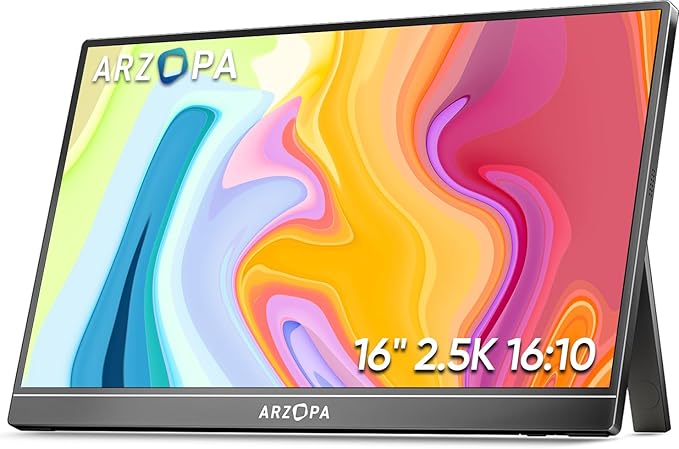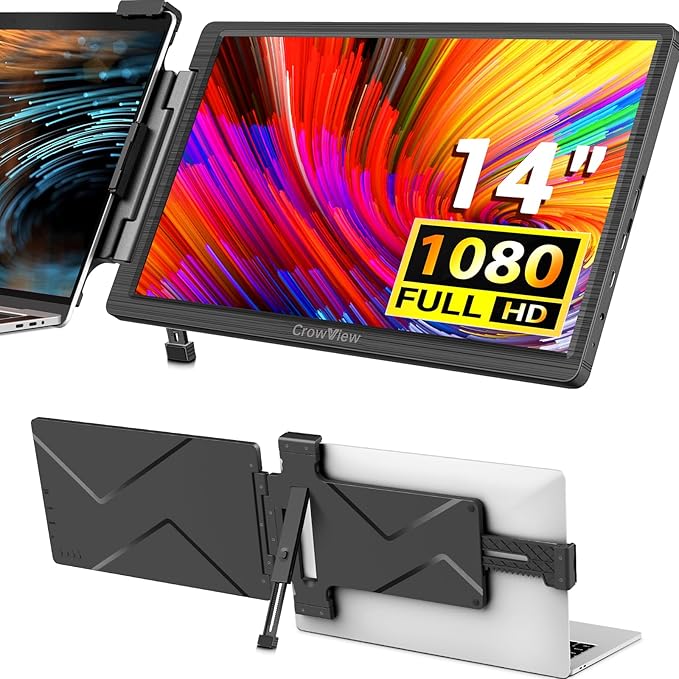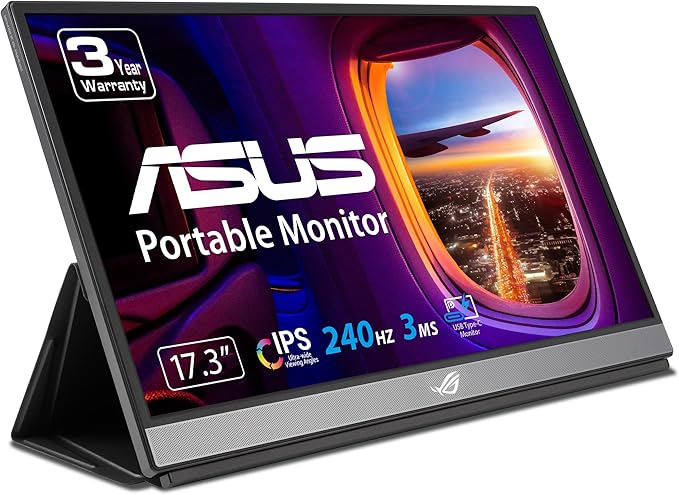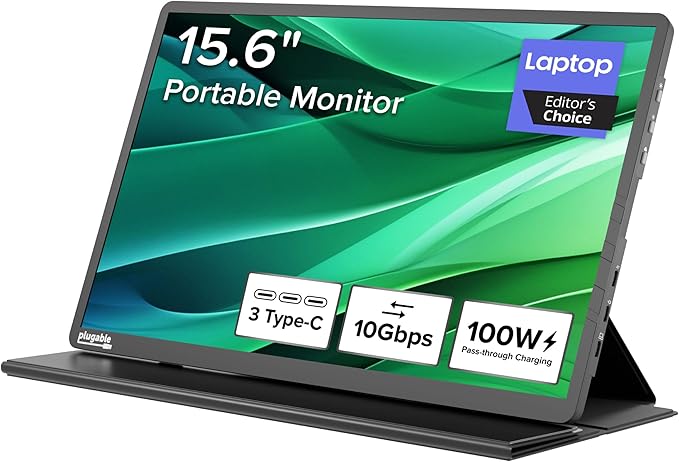Best Portable Monitors 2025
Discover the best portable monitors that solve your screen limitations while traveling. If your current mobile display holds back your productivity, you’re not alone. Our guide reveals must-have travel monitors that boost efficiency and transform your workspace on the go. Embrace these innovative solutions to make work feel effortless and conquer tasks with confidence. Read on to learn how upgrading your setup can change the way you work every day.
Contents
- Top 5 Portable Monitors:
- 1. Arzopa Z1RC – Best Portable Monitor Overall
- 2. Elecrow CrowView – Best Value Portable Monitor
- 3. Viewsonic VX1655-4K-OLED – Best Portable Monitor for Creators
- 4. Asus ROG Strix XG17AHPE – Best Portable Gaming Monitor
- 5. Plugable 15.6-inch USB-C Portable Display (USBC-PDMON) – Best Budget Portable Monitor
- Things To Consider When Buying a Portable Monitor:
- Types of Portable Monitors
- LCD vs. LED
- Touchscreen vs. Non-Touchscreen
- Key Factors to Consider
- Size and Resolution
- Connectivity Options
- Tips for Buying a Portable Monitor
- Assessing Your Needs
- Budget Considerations
- Step-by-Step Buying Guide
- Research and Comparison
- Where to Purchase
- Pros and Cons of Portable Monitors
- Advantages
- Disadvantages
- Common Use Cases
- Gaming
- Professional Use
- Conclusion
Top 5 Portable Monitors:
1. Arzopa Z1RC – Best Portable Monitor Overall

Enter the Arzopa Z1RC — the best portable monitor for most people. This device excels with an incredible 16-inch, 2.5K display — a perfect fusion of clarity and price. With USB-C and mini HDMI connectivity, it works with many devices, making it a versatile companion for work or play.
And its IPS panel is one of the most impressive aspects of it. You get excellent resolution at 2560 x 1600 pixels, so can expect crisp images whether you’re streaming a movie or opening up your PowerPoint for a presentation. With dual USB-C ports, connecting your devices has never been easier, and the mini HDMI port adds even greater versatility. At just 763g and a svelte 9mm thick it’s super portable, slipping into your bag easily.
Color coverage gives us 100% sRGB and good readings in other color spaces. The viewing angle is a little narrow at 85 degrees, but this monitor will still do well in most everyday applications. You may also notice that it does not hit the claimed 500nits peak brightness. It is decent, nonetheless, punching around 337 nits, enough for some indoor times.
The balance of affordability and features is what impresses the most. This model does not have some of the high-end bells and whistles, but it provides everything that a casual user would want. Recommended for traveling, a protective case making it more durable while on the go.
Few portable monitors can compete with Z1RC on value. This monitor is perfect for those looking for reliability and performance without breaking the bank.
2. Elecrow CrowView – Best Value Portable Monitor

The overly saturated marketplace for budget panels is where Elecrow’s CrowView shines. After extensive use of the display, we are happy to declare it taking Best Value Portable Monitor.
With a lightweight body, this monitor is easy to move around, great for on-the-go professionals. Flexibility from Multiple Usage Modes Placing it alongside your laptop improves productivity. You can even clamp that to your laptop lid for dual-screen efficiency. Using the display in portrait mode is even better for work that requires vertical real estate, such as coding or reading documents.
HDMI and Display Port for connectivity is a treat. While many monitors skimp on ports, the CrowView has everything you need for easy connectivity. Physically, it mounts to laptops 13 to 16.5 inches across to work with most models.
The monitor performs well, but its on-screen display (OSD) is a little tricky to navigate. If the button placements may need a bit of getting used to, then this small annoyance is vileFile4 — beOdysseyOWAthen a painfully small price to pay for such stellar in-car experience.
The best part about the CrowView is that it increases productivity without being a drain on your wallet. This monitor stands out from all its contemporaries due to its portability and various usage options.
For those looking for value and function, this is the monitor for you. Check out the Elecrow CrowView to help you reshape the way you work!
3. Viewsonic VX1655-4K-OLED – Best Portable Monitor for Creators

Creators, meet the Viewsonic VX1655-4K-OLED—the stunning portable monitor you didn’t know you needed. This outstanding display offers brilliant sharpness, vivid colors and impressive contrast, and is our choice for professionals.
Bright environments won’t be a problem, with this monitor achieving a stunning peak brightness of 457 nits. You’ll love your images pop, feels like overall productivity. Its wide color gamut really shines for tasks where color matters most — like photography and design. Its native 3840×2160 pixels make working with 4K resolutions a doddle, ensuring smoother-than-ever video edits.
A strong design offers simple, low-effort convenience. And an integrated kickstand lets you pop up in a snap wherever you are. The slim bezels and sturdy chassis provide stability while working on creative projects. Connectivity options also do well: two USB-C ports and a mini-HDMI port means versatile usage. For those who want more conventional compatibility, being a full-sized HDMI port would be ideal.
The bundled display cover is a little flimsy, but this is a minor quibble compared to the monitor’s stand-out performance. The on-screen menus may seem complicated at first, but you will learn your way around. You will appreciate how the VX1655-4K-OLED enhances your work experience, driving you to create without compromise.
4. Asus ROG Strix XG17AHPE – Best Portable Gaming Monitor

Say hello to the Asus ROG Strix XG17AHPE — the world’s best portable gaming monitor. Where the competition fails, this monitor breaks through with vivid 17.3 inches full HD display and incredible 240Hz refresh rate.
One unique aspect is that it’s ultra-slim—it’s only 0.40 inches thick—which makes it easy to carry with you anywhere. At around 1kg you’ll hardly notice it in your bag. The device itself has many varieties of connectivity options including USB-C and miniHDMI.
In gaming, colors stand out but never seem oversaturated. Whether you’re playing Overwatch or Call of Duty, even darker scenes become clearer thanks to vivid visuals. Such clarity ensures you remain absorbed without losing critical information. Plus, a 240Hz refresh rate means your games will run smoothly. You won’t find yourself stuck at fast-paced matches because you experience no ghosting or blur.
Radiating sound with a loud and clear punch, the audio quality pleasantly surprised us, which further intensifies the gaming experience. In addition to an easy setup with a carrying case and compact tripod, something that many other portable monitors are missing.
If you mainly watch shows or deliver presentations, you may find this monitor overkill. But it actually does really well in those respects too. With current consoles only supporting up to 120Hz, this monitor is future-proof for your gaming pursuits.
What’s really impressive, though, is how Asus managed to meld utility and portability with no compromises. Serious gamers looking for a premium display, look no further than the Asus ROG Strix XG17AHPE!
5. Plugable 15.6-inch USB-C Portable Display (USBC-PDMON) – Best Budget Portable Monitor

If you’re looking for portable displays, this 15.6-inch USB-C Portable Display from Plugable is a great option. This monitor redefines what budget-friendly tech means. No HDMI here, but three USB Type-C ports offer plenty of connectivity and hub functionality. You also get two 10Gbps connections, ensuring you’re well-connected on the go, and 85-watt passthrough charging. You typically won’t even need the included power brick to connect to your laptop.
It won’t win any performance awards (300 nits, 60 Hz refresh rate), but it can settle for plenty of healthy high-spec performance for an everyday use experience. Viewing angles are also excellent, with bright, vibrant, and sharp colors when viewed on-head, far outpacing most displays in the same price range. The viewing angles could be better, as the images degrade at acute angles. Most users, however, find their ideal viewing position.
What you’ll love is the pragmatic addition of a folding magnetic cover that acts as a kickstand. It already includes a USB-C 3.2 cable, so Plugable makes sure you have what you need to get
My favorite part is the low power draw. The freedom of having a portable display that you don’t have to constantly be fussing with to charge three times a day is a liberating experience.
While the use of a few more outstanding features can be expected, this monitor demonstrates that a well-planned outlook is what really matters.
As a budget portable monitor, it goes above and beyond; it’s an overachiever.
Things To Consider When Buying a Portable Monitor:
You are about to explore the necessary factors that influence your decision when purchasing a portable monitor. With the increasing need for flexibility in working and gaming environments, having the right portable monitor can significantly enhance your experience. This guide will help you navigate through display quality, connectivity options, size, and other specifications to ensure you choose a monitor that best fits your lifestyle and needs. Equip yourself with the knowledge to make an informed purchasing decision today!
Types of Portable Monitors
A variety of portable monitors are available, each suited to different needs and preferences. Here’s a breakdown of some common types:
LCD vs. LED
Even though both LCD and LED monitors can provide high-quality displays, they do differ in brightness and contrast. LED monitors, which are necessaryly a type of LCD, utilize backlighting with diodes that enhances the overall picture quality. This means you can expect a vivid display with LED, making them ideal for watching videos or engaging in graphic-intensive tasks.
Touchscreen vs. Non-Touchscreen
To choose between touchscreen and non-touchscreen monitors, think about how you plan to use your device. Touchscreen monitors allow for direct interaction with your content, making actions like zooming or scrolling intuitive. On the other hand, non-touchscreen versions might be more affordable and sufficient for stationary use.
Another critical aspect to consider with touchscreen versus non-touchscreen monitors is the potential for increased functionality. Touchscreens can facilitate a more interactive experience, which can be advantageous for tasks such as drawing, designing, or navigating software. However, if you primarily use your monitor for standard tasks like browsing or spreadsheet management, a non-touchscreen model might serve you well without the extra cost. Your choice should align with the specific tasks and interactions you envision for your portable monitor.
Key Factors to Consider
You should take several key factors into account when choosing a portable monitor to ensure it meets your needs. Consider the following:
- Size
- Resolution
- Weight and portability
- Connectivity options
- Battery life
Perceiving how these elements align with your usage will guide you in making the best decision.
Size and Resolution
You will want to think about the size and resolution that best fit your tasks. Larger monitors provide a more immersive experience, while higher resolutions enhance clarity and detail. Optimal choices typically range from 15 to 17 inches for portability without sacrificing visibility.
Connectivity Options
Even small differences in connectivity can impact your experience significantly. Look for monitors that provide various ports such as HDMI, USB-C, and DisplayPort to ensure compatibility with your devices.
It’s also beneficial to check whether the monitor supports power delivery over USB-C, allowing you to charge your device while connected. This feature enhances your portability by minimizing the number of cables you need. Additionally, consider whether the monitor includes built-in speakers or headphone jacks, which can improve your overall user experience when viewing content or engaging in remote work.
Tips for Buying a Portable Monitor
Now that you’re ready to enhance your mobile workspace, consider the following tips when selecting a portable monitor:
- Evaluate screen size and resolution to determine what fits your usage.
- Check connectivity options like HDMI and USB-C for compatibility.
- Look for lightweight and slim designs for easy transport.
- Review battery life if you require mobility and want cordless operation.
- Read user reviews and ratings for insights on performance.
Recognizing these factors will empower you to make an informed decision.
Assessing Your Needs
On your journey to find the ideal portable monitor, it’s necessary to assess your personal and professional needs. Consider how you’ll primarily use the monitor, whether for work presentations, gaming, or graphic design. Understanding your requirements will help you choose a device with the right specifications, such as refresh rates and color accuracy, tailored to your usage scenario.
Budget Considerations
Even if you have a specific need in mind, your budget ultimately dictates the options available to you. Set a realistic budget range before you start shopping, ensuring you account for features that matter most. This approach will help you navigate through various models without overspending.
Considerations such as display quality, portability, and brand reputation may affect the overall price. While it can be tempting to opt for the cheapest option, investing in a quality portable monitor can provide better durability and performance. Balance your preferences with available funds to find a device that meets your needs without compromising quality.
Step-by-Step Buying Guide
To ensure you invest wisely in a portable monitor, follow this simple step-by-step buying guide. By understanding key features and your specific needs, you can make a well-informed decision.
Research and Comparison
On your journey to find the best portable monitor, thorough research and comparison will make a significant difference. Explore various brands and their offerings, while comparing specifications to meet your needs.
Where to Purchase
Comparison shopping is key when selecting a portable monitor. You can find a variety of options both online and in-store, which allows you to compare prices, features, and availability. Look for popular e-commerce platforms and local electronics retailers to make the best choice.
Buying from reliable sources ensures you receive quality products and customer support. Online marketplaces often have competitive prices and user reviews that can guide your decision. Local electronics stores may offer hands-on experiences and consultations to help you select the ideal portable monitor for your needs.
Pros and Cons of Portable Monitors
Your decision to buy a portable monitor should be informed by understanding both the advantages and disadvantages it brings. Below is a summary of these factors:
| Pros | Cons |
|---|---|
| Lightweight and easy to carry | Can have lower resolution |
| Increases productivity | Limited connectivity options |
| Flexible screen positioning | May require additional power source |
| Enhanced multitasking ability | Possible screen size limitations |
| Compatible with multiple devices | Durability concerns |
Advantages
Some portable monitors significantly enhance your productivity by providing additional screen space, making multitasking easier. Their lightweight design allows for convenient transport, letting you set up a dual-screen workspace anywhere. They also offer compatibility across various devices and flexible positioning for better ergonomics.
Disadvantages
On the other hand, portable monitors can come with certain drawbacks that you should consider before making a purchase.
Understanding these disadvantages may help you make a more informed decision. Many portable monitors feature lower resolution compared to traditional monitors, which might affect visual quality. Connectivity options can be limited, requiring you to ensure that you have compatible ports. Additionally, some models may necessitate an extra power source or have durability issues, impacting their long-term reliability. Finally, the smaller screen size relative to desktop monitors can feel confining, especially when working with intricate tasks or significant amounts of data.
Common Use Cases
Once again, portable monitors offer versatility and enhance productivity across various activities. Whether you are gaming, working on presentations, or simply multitasking, having an additional screen can significantly improve your experience. As you explore the market, identifying your primary use cases will help guide your decision and ensure you select the best model that fits your lifestyle.
Gaming
Common use cases for portable monitors in gaming include providing an expansive viewing experience and facilitating multiplayer gaming on-the-go. You can connect your portable monitor to a gaming console or laptop, making it easier to play with friends or participate in gaming tournaments without being confined to a single display.
Professional Use
Assuming your focus is on professional applications, a portable monitor can greatly enhance your workflow. Having a second screen allows for simultaneous viewing of documents, presentations, and data, making it easier to collaborate or analyze information effectively.
Understanding the professional benefits of a portable monitor can lead to more efficient work habits. You can use it for video conferences, where the additional display allows you to share presentations while keeping notes or other applications open. This setup can streamline your tasks, make remote work more manageable, and improve your overall productivity during business meetings or client engagements.
Conclusion
To wrap up, when buying a portable monitor, you should consider factors such as screen size, resolution, connectivity options, and overall portability. Evaluate your specific needs, whether for work or entertainment, and choose a monitor that fits seamlessly into your lifestyle. Additionally, keep an eye on battery life and display quality, ensuring you select a device that enhances your productivity and viewing experience while remaining easy to transport. Your investment in the right portable monitor can significantly enhance your workflow and enjoyment.